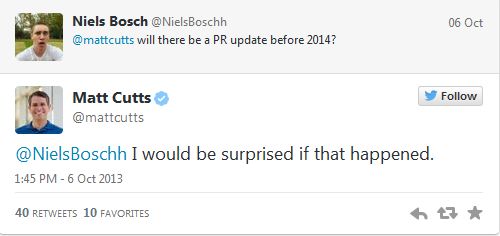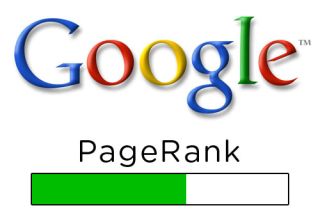PageRank Dead? – What Will Replace the "Green Standard?"
Just about every backlink reporting service has developed a metric to compete with PageRank. Here are four resources that may be good alternatives.
Just about every backlink reporting service has developed a metric to compete with PageRank. Here are four resources that may be good alternatives.
The first time that SEOs were faced with the prospect of PageRank going away was a year ago, when Matt Cuts suggested that there would be no further updates in 2013.

Source: SEORoundtable.com
Later that same month, Cutts indicated the pipeline that pushes PageRank data from the internal Google servers to the toolbar broke and there were no plans to fix it. It was widely speculated at that time that there would never be another PageRank update. But just six weeks later, PageRank updated on December 6.
Fast-forward exactly one year after the first scare to October 6, 2014, and Googler John Mueller got everyone’s attention when he stated, “We’ll probably not…be updating it [PageRank] moving forward.” You will find this at 20:30 in the following Google+ Hangout video.
So…that means one of two things. Google may or may not update the PageRank bar in the future. Regardless of what happens in the short term, now is the time to consider alternatives.
PageRank is a nice link-building metric to show clients, because most are familiar with it. That said, with the advent of Hummingbird and the ability of Google to understand relationships, relevance is every bit as important as PageRank. In fact, I think a strong argument can be made that moving forward, relevance will become increasingly important – much more so than PageRank alone.
Where I find PageRank most useful is in performing link audits. By using PageRank, we can easily spot low-value and spammy links with filters like Homepage PR0 or Gray + Internal Page PR0 or Gray. This metric becomes less reliable, as the frequency of the updates lag.
 PageRank is calculated using a logarithmic scale (similar to the Richter scale), with a value ranging from 0 to 10. It has an estimated base of 4-5. In other words, assuming a base of 5, PR2 links are comparable to 5 PR1 links; a PR6 link is comparable to 5 PR5 links, and so on.
PageRank is calculated using a logarithmic scale (similar to the Richter scale), with a value ranging from 0 to 10. It has an estimated base of 4-5. In other words, assuming a base of 5, PR2 links are comparable to 5 PR1 links; a PR6 link is comparable to 5 PR5 links, and so on.
Just about every backlink reporting service has developed a metric to compete with PageRank. In this post, I’ll review the four resources that I have found to be the best alternatives to PageRank. That group includes Moz, Majestic, Ahrefs, and Blekko.
According to Moz, Page Authorityis a calculated metric designed to predict how well a given Web page is likely to rank in Google’s SERPs. It uses a machine learning model to find an algorithm which correlates with rankings across search results to make that prediction.

Page Authority is scored on a 100-point, logarithmic scale. As with PageRank, it’s MUCH easier to grow your score from 10 to 20 than it would be to grow it from 30 to 40. Regular updates sometimes lead to a fluctuation in score. For comparison sake, Searchenginewatch.com has a Page Authority of 92 (vs a PR7).
According to Majestic, the Trust Flow metric originates from a large pool of manually reviewed Web pages. This by no means includes every trusted website on the Internet, yet appears to provide an adequate base. Their rationale is that trustworthy websites tend to link to other trustworthy sites. Those neighbors, in turn, have a tendency to link to other trustworthy neighbors and so on.

Dixon Jones from Majestic commented recently that “If you want the strongest metric of quality, then I think you should look at Trust Flow.” For comparison sake, Searchenginewatch.com has a Trust Flow of 54 (vs. a PR7).
According to Ahrefs, this scale is derived from measuring the impact of all backlinks with varying link equity to a given page. Using the example of a page with a URL rank of 100 and 10 do-follow links:
The Ahrefs algorithm allows for no more than 80 percent of its rating to pass through to another page. That means a page with the rating of 100 passes through a rating of 80. This rating 80 gets divided between the do-follow links. In this example, each link will get a pass-through value of eight.

This process is repeated over and over for every page. Internal links are also included in the rating calculation. As a general rule, the more backlinks a given URL has – the higher URL Rank it receives. That said, it’s not strictly a numbers game. One high-value link can give more boost to ranking than hundreds of spammy backlinks. For comparison sake, Searchenginewatch.com has a URL Rank of 85 (vs. a PR7).
Unlike the others, Host Rank is on a linear scale, rather than a logarithmic scale. The score can range from 0 to unlimited. For benchmarking purposes, Google has a Host Rank of 16,735 as compared to Search Engine Watch with a Host rank of 1,370. Keeping in mind these sites respectively have a PageRank of 9 and 7, by using the Blekko scale, it is much easier to visualize the actual spread between the two websites.

Unfortunately, Blekko no longer offers a site explorer feature, so one must rely upon their API or use a third-party toolbar browser extension.
Moz, Majestic, and Ahrfs have all done a pretty decent job in mimicking the PageRank algorithm. Dixon Jones, of Majestic, reports the following level of correlation between Google PageRank and other scales:
Moz Page Authority correlate at 0.68 (2012 Figure)
Majestic Trust flow correlates at 72.79 percent
Ahrefs Domain Rank correlates at 76.32 percent (He did not provide URL rank)
Any one of them, used consistently, should work fine for comparative purposes. For the added linear dimension and quick understanding of relative trust and authority among sites, I recommend mixing in Blekko.